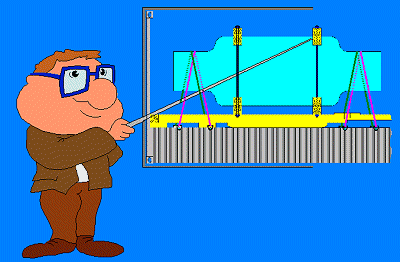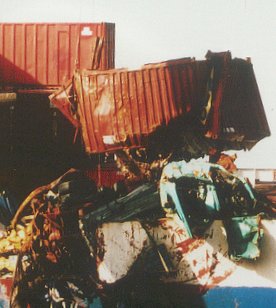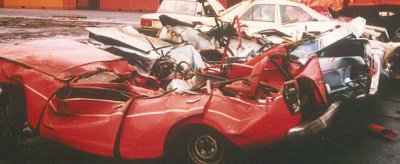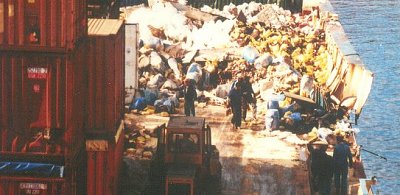- These Guidelines, which are not all-inclusive, are essential to the safe packing of CTUs by those responsible for the packing and securing of the cargo and by those whose task it is to train people to pack such units. Training is essential if safety standards are to be maintained.
According to section 7.2 of the CTU packing guidelines, this is a management responsibility:
- Management should ensure that all personnel involved in the packing of cargo in CTUs or in the supervision thereof are adequately trained and appropriately qualified, commensurate with their responsibilities within their organization.
Section 7.3 states the following requirement for personnel:
- All persons engaged in the transport or packing of cargo in CTUs should receive training on the safe packing of cargo in CTUs, commensurate with their responsibilities.
Section 7.4 relates to training, the various subsections providing as follows:
- 7.4.1 General awareness/familiarization training:
All persons should receive training on the safe transport and packing of cargo, commensurate with their duties. The training should be designed to provide an appreciation of the consequences of badly packed and secured cargo in CTUs, the legal requirements, the magnitude of forces which may act on cargo during road, rail and sea transport, as well as basic principles of packing and securing of cargoes in CTUs.
- 7.4.2 Function-specific training:
All persons should receive detailed training concerning specific requirements for the transport and packing of cargo in CTUs which are applicable to the functions that they perform.
- 7.4.3 Verification:
The adequacy of the knowledge of any person to be employed in work involving the packing of cargo in CTUs should be verified or appropriate training provided. This should be supplemented by periodic training, as deemed appropriate by the regulatory authority.
- 7.5 Recommended course syllabus - overview:
The adequacy of the knowledge of any persons to be employed in work involving the packing of cargoes in CTUs should be verified, in the absence of which appropriate training is considered essential and should be provided. The function-specific training should be commensurate with the duties required to be performed by an individual in the packing and securing of cargo in CTUs. Topics for consideration, to be included in the training as appropriate, are given in Annex 6.
 |
|
Annex 6
Topics to be included in a training programme for the packing and securing of cargoes in cargo transport units (CTUs)
| 1 | Consequences of badly packed and secured cargo | |
| 1.1 | Injuries to persons and damage to the environment | |
| 1.2 | Damage to ships and CTUs | |
| 1.3 | Damage to cargo | |
| 1.4 | Economic consequences | |
Many may still remember the case of the French container ship "Sherbro" which lost a number of containers overboard in the English Channel. As a result, hundreds of thousands of plastic sachets containing the pesticide Apron plus entered the sea and were subsequently washed up on the coasts of France, the Netherlands and Germany.
 |
 |
|
| Injuries to persons and damage to the environment may be the result. | ||
 |
Damage to ships and CTUs |
 |
|
| Damage to cargo |
 |
|
| Economic consequences |
| 2 | Liabilities | |
| 2.1 | Different parties involved in cargo transport | |
| 2.2 | Legal responsibility | |
| 2.3 | Goodwill responsibility | |
| 2.4 | Quality assurance | |
| 3 | Forces acting on the cargo during transport | |
| 3.1 | Road transport | |
| 3.2 | Rail transport | |
| 3.3 | Sea transport | |
| 4 | Basic principles for cargo packing and securing | |
| 4.1 | Prevention from sliding | |
| 4.2 | Prevention from tipping | |
| 4.3 | Influence of friction | |
| 4.4 | Basic principles for cargo securing | |
| 4.5 | Dimensions of securing arrangements for combined transportation | |
| 5 | CTUs - types | |
| 5.1 | Containers | |
| 5.2 | Flats | |
| 5.3 | Swap-body | |
| 5.4 | Road vehicles | |
| 5.5 | Rail cars/wagons | |
| 6 | Cargo care consciousness and cargo planning | |
| 6.1 | Choice of transport means | |
| 6.2 | Choice of CTU type | |
| 6.3 | Check of CTU prior to packing | |
| 6.4 | Cargo distribution in CTUs | |
| 6.5 | Requirements from the receiver of cargo regarding cargo packing | |
| 6.6 | Condensation risks in CTUs | |
| 6.7 | Symbols for cargo handling | |
| 7 | Different methods for cargo packing and securing | |
| 7.1 | Lashing | |
| 7.2 | Blocking and bracing | |
| 7.3 | Increasing friction | |
| 8 | Equipment for securing and protection of cargo | |
| 8.1 | Fixed equipment on CTUs | |
| 8.2 | Reusable cargo securing equipment | |
| 8.3 | One-way equipment | |
| 8.4 | Inspection and rejection of securing equipment | |
| 9 | Packing and securing of unitized cargo (bulk) | |
| 9.1 | Cases (boxes) | |
| 9.2 | Palletized cargoes | |
| 9.3 | Bales and bundles | |
| 9.4 | Bags on pallets | |
| 9.5 | Flexible IBCs | |
| 9.6 | Slabs and panels | |
| 9.7 | Barrels | |
| 9.8 | Pipes | |
| 9.9 | Cartons | |
| 10 | Packing and securing of non-unitized cargo (break-bulk) | |
| 10.1 | Different types of packaged cargoes loaded together | |
| 10.2 | Packing of heavy and light cargoes together | |
| 10.3 | Packing of rigid and non-rigid cargoes together | |
| 10.4 | Packing of long and short cargoes together | |
| 10.5 | Packing of high and low cargoes together | |
| 10.6 | Packing of liquid and dry cargoes together | |
| 11 | Packing and securing of paper products | |
| 11.1 | General guidelines for the packing and securing of paper products | |
| 11.2 | Vertical rolls | |
| 11.3 | Horizontal rolls | |
| 11.4 | Sheet paper on pallets | |
| 12 | Packing and securing of cargo requiring special techniques | |
| 12.1 | Steel coils | |
| 12.2 | Cable drums (reels) | |
| 12.3 | Wire coils | |
| 12.4 | Steel slabs | |
| 12.5 | Steel plates (sheet) | |
| 12.6 | Big pipes | |
| 12.7 | Stone blocks | |
| 12.8 | Machines | |
| 13 | Packing and securing of dangerous cargoes | |
| 13.1 | Regulations for the transport of dangerous cargoes | |
| 13.2 | Definitions | |
| 13.3 | Packing regulations | |
| 13.4 | Packing, separation and securing | |
| 13.5 | Labeling and placarding | |
| 13.6 | Information transfer when transporting dangerous cargoes | |
| 13.7 | Liabilities | |
Comprehensive and regularly recurring training sessions are necessary in order to ensure sufficient familiarity. On request, the German Insurance Association (GDV e.V.) can supply the names of training organizations which carry out or assist with internal and external training.